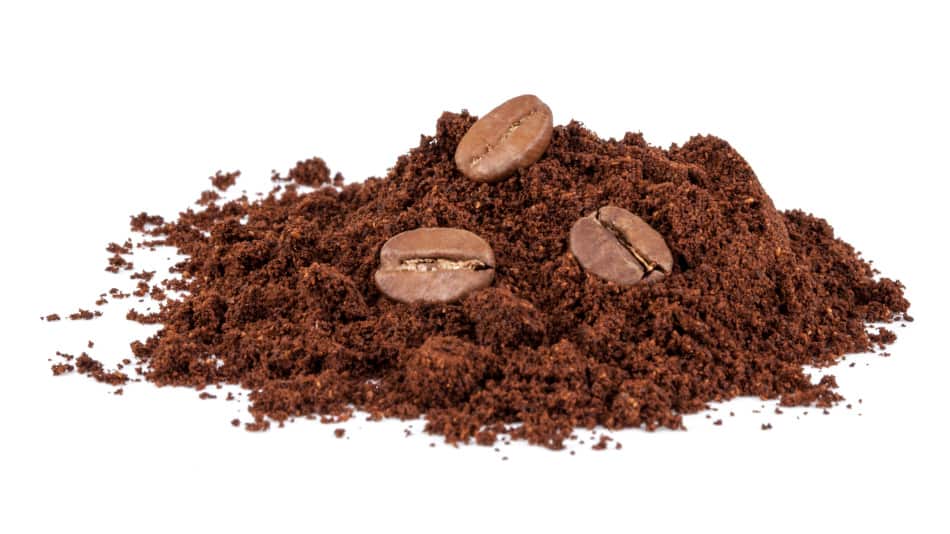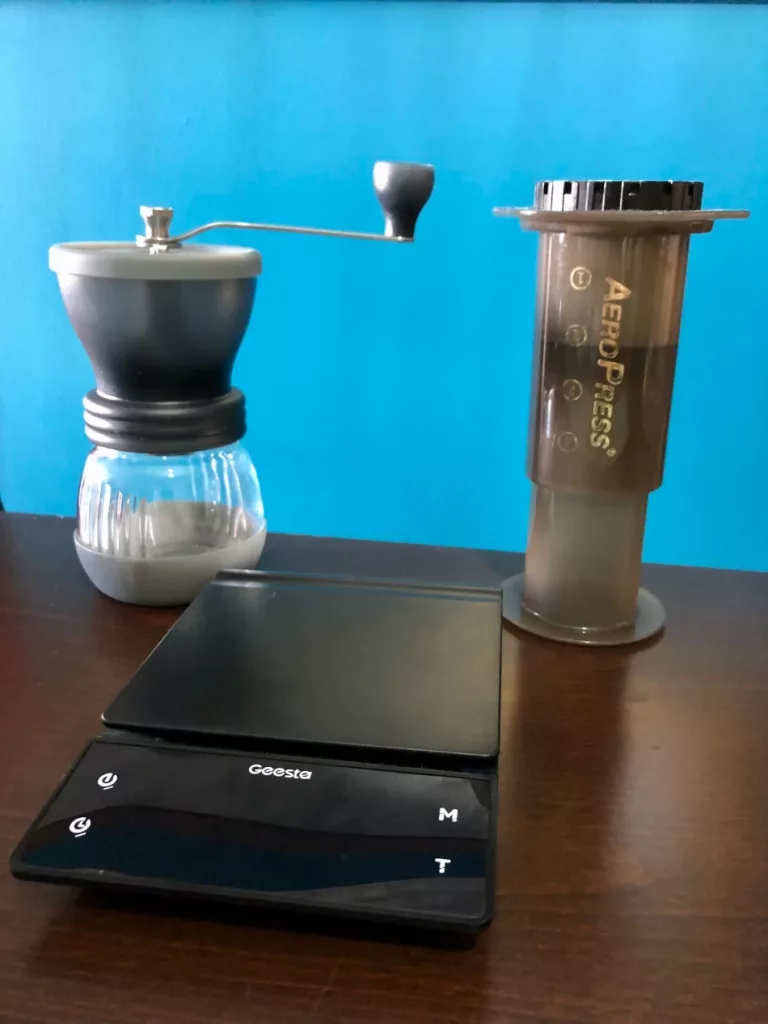Grinding your coffee is a crucial task in the brewing process. Your grind size will have an impact on most, if not all, of the coffee attributes or features: aroma, fragrance, taste, acidity, and the body of your drink.
To extract the most flavor from your grounded coffee, you need to increase the time that hot water is in contact with the grounded beans. Faster methods like espresso demand extra fine grinds, AeroPress suggests medium-fine, while french press suggests a coarser grind.

The best way to grind coffee for flavor is to adjust your grinding size accordingly.
Not all brewing methods are created equal
The less surface of the beans gets in contact with the hot water, the less flavor you would extract from the bean. Grinding coffee increases the bean surface, sort of say. Coarse grind has less surface, while extra-fine grind hast the most available surface to contact the water.
| Brew method | Grind Size | Size in millimeters | Reference |
| Turkish Coffee | Extra Fine | 0.10 | Powdered sugar |
| Espresso | Fine | 0.30 | Table Salt |
| AeroPress, Moka Pot, Pour Over Cone | Medium Fine | 0.50 | Beach Sand |
| Pour Over & Flat Bottom Drip Coffee | Medium | 0.60 | Peat Moss |
| Chemex coffee maker, Clever Dripper, Cafe Solo Brewer | Medium Coarse | 0.75 | Rocky Sand |
| French Press | Coarse | 1 | Flaky Sea Salt |
| Cold Brew | Extra Coarse | 1.50 | Ground peppercorns |
It also works the other way around; the longer the water will be in contact with the water, the coarser the grind should be.
The best approach is to try it by yourself. Use different settings and experience the difference. There is a significant impact on the bean itself. Robusta-based coffee could require a finer grind for your particular method than a single-origin, single-lot specialty coffee.
Best Grind for French Press
Coarsely ground coffee is the best approach for French Press. Considering that the hot water will be in contact with the grounded coffee, up to 4 minutes sometimes, you will have plenty of time for that water to extract flavor from your bean.
The percolation method has gained a lot of acceptance for flavor extraction; because of the extraction time, the un-experienced user a broader margin of error for making mistakes and still getting a good cup of coffee.
For this method, all of the water will contact all of the grounded coffee, which translates into total extraction.
When I want to get that extra kick of body in my coffee, the French press is my choice.
Best Flavor for Chemex
The Chemex method suggests a medium grind, considering the amount of time the hot water will contact the grounded coffee while it flows down. Since you have a conic shape, you would increase the contact of the water while it passes through the beans.
Best Flavor for Pour Over
Pour Over, such as V60, reduces the time that the water stays in contact with the hot water, so we need a medium to fine grind.
If you go too small on grind size, your water and coffee mixture will develop a dirty look, and it will also over-extract your coffee.
Best Grind for AeroPress
Fine to medium-fine is my go-to setting. My personal preference landed for the AeroPress getting the best of the specialty coffee medium roasted that I usually get. When I have brewed dark roasted coffee, I need to go more into the medium size grind to reduce surface contact with the hot water and get a sweeter cup.
AeroPress is one, if not the most, versatile coffee brewing device. That being said, there are several theories about using coarse grind to brew coffee that can also produce a high-quality coffee cup. I have tried a few times coarser grinds and said that I could get high flavor coffee from a medium grind than a medium-fine grind.
Best Grind for Espresso
The ideal size is tiny pieces, those you would get from a fine grind. Since the espresso extraction time is less than a minute and with little liquid (1 ounce of hot water / 30 ml, for example), the only way to have more water contact with the coffee surface is to increase the coffee surface by grinding fine.
Espresso extraction takes from 26 to 30 seconds.
Turkish Coffee
The Turkish brewing method requires extra fine ground coffee.
Size is not the only variable
The grind size is not the only relevant to extract the best from your coffee. Other variables also have an impact on your final product.
It is essential to read your coffee before preparing your cup. For commercial coffees, you need to be aware of the primary flavors associated with that type of bean. Commercial coffees are mostly comprised of dry nuts, cocoa, chocolate, and vegetables. These are coffees on the bitter side of the coffee spectrum. To reduce bitterness, increase grind size.
But, if you have a specialty coffee (80+ points in the Specialty Coffee Association scale) in your hands, the best way to extract those sweet flavors from sugar cane, or citric flavors, such as orange, lime, tangerine, or berry, is to explore and locate the sweet spot. To increase extraction, reduce grind size.
Always read your coffee package. If your coffee describes the altitude of the farm where these beans were grown, this is a key element to your brewing. At higher altitudes, you may need to go finer than other coffees.
Hight quality coffee would also communicate the roasting level. Darker the roast should have a coarser grind than medium or lightly roasted coffee.
There are several methods to brew coffee, and each method could have different recipes. In my experience, one of the most versatile devices to brew is the AeroPress.
Nothing beats you experimenting with your equipment and your materials. For example, some people suggest that dark roasted coffee beans should be brewed with water at 180°F – 190°F; this should promote the extraction of the sweet taste. If your coffee is medium roasted, water at 195°F – 205°F could be more efficient in extracting sweetness. You will only know if you try it.
Freshness
The roast date of your beans is very important. The ideal time is between 3 days and 14 days of the roast date. Later than 14 days, your bean will start to lose freshness.
You would get the best flavor by grinding right before brewing your coffee. If you grind your coffee and not brew it right away, the following things will start to happen to it:
- Flavors and aromas would leave the coffee.
- Staling reactions will create new flavors that won’t necessarily be nice or appealing to your taste.
- Oxidation that will create a rancid taste and smell.
In short words, freshly ground is better for flavor.
Uniformity
Uniform grind creates a uniform cup of coffee. If your grinder is not capable of creating pieces relatively the same size, that will also have an impact on your drink:
- Having smaller pieces than average can add bitterness
- Having bigger pieces than average can add sourness
- Having a myriad of sizes will result in an unbalanced product.
In short words, uniformity is better for flavor.
In my experience, when I use my Hario Skerton Ceramic Coffee Mill, I get a consistent grind size all across the ground. Here you would get to see its price. Whenever I want to secure a good, balanced coffee cup, my lineup is Hario + Digital Balance + Aeropress.

On the other hand, when I use my Sboly automatic coffee grinder, even though it also has a canonical burr, I still get a variety of sizes across one specific grind. In my experience, this has produced bitter cups.
Water Quality
Depending on the brewing method, water can comprise up to 90% of your coffee. Therefore, the better the water, the better your coffee drink.
Using water with a lot of minerals, let’s say something around 400 parts per million (ppm), will result in a bitter cup.
On the other hand, having flat water with 16-20 parts per million (or miligrams/L) of minerals within the liquid will result in a sour cup.
The sweet spot for mineral content on the water is between 50 and 150 parts per million (ppm).
In short words, balanced water results in a better cup.
There are a few options to have your water within the excellence levels, converting your regular water into suitable water using the the following products:
- Third Wave Water (also available on Amazon – Light and Medium Roast | Amazon – Dark Roast
- Perfect Coffee Water
- Global Customized Water
- Aqua Code Waters
Water Temperature
Water too hot will have a negative impact on the water. You should adjust your water temperature to the roast level.
Dark roast requires a higher temperature 90º F
Medium roast suggest medium temperature 85º F
Light Roast gets the best at 80º F
We have a full temperature article for Aeropress here, in case you are interested and this is your brewing device.
Roast Level
Light roast coffee, requires a very long extraction.
Medium roast coffee, requires an average extraction.
Dark roasted coffee, you can go below average.
How you can control the duration of the extraction? two ways: increase the time of water in contact with the ground coffee or grind the coffee finer, which increases the grounded coffee area that is in contact with the water.
Conclusion
- There are a lot of moving parts when brewing your coffee.
- The recipe shall be adapted to the bean. Not all recipes work for all beans.
- Buy whole beans, roasted no more than 14 days ago.
- Grind right before you brew.
- Grind size is not the only variable. (water, consistency, temperature, roast level, etc.)